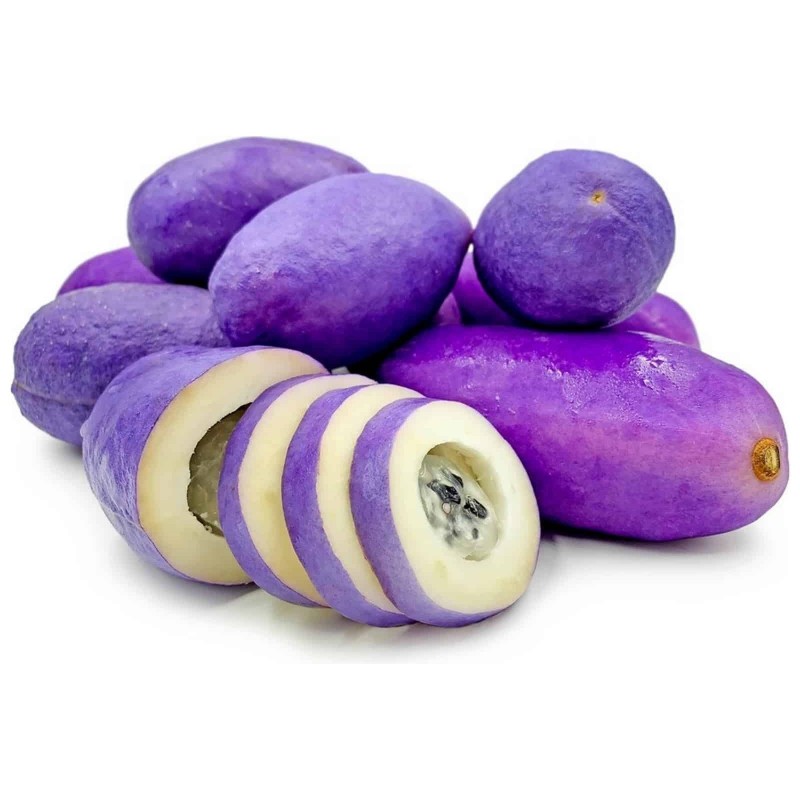
Threeleaf Akebia seeds (Akebia trifoliata)
Threeleaf Akebia seeds (akebia trifoliata)
Price for Package of 5 seeds.
Akebia fruit has a purple color not often seen in nature. It is the size of a russet potato and is soft to the touch. A slice can be removed from the thick rind of a domesticated Akebi fruit, whereas the wild grown fruits must be allowed to split on their own indicating ripeness. Inside of the Akebi fruit is a sweet translucent white flesh (similar in look and texture to a lychee) with a taste somewhat like pear. The flesh is filled with shiny black seeds.
Seasons - Availability
Akebi fruit is only available for two weeks out of the year; its season is at the very beginning of fall.
Current Facts
Akebi fruit is both wild and cultivated. The exotic looking fruit is found in Japan during a very brief period at the end of the summer or early fall. Because of the short availability, distribution is somewhat limited to just a few stores and in limited quantity.
Applications
The inner flesh of the Akebi fruit is usually eaten fresh, slurped from the purple pod. Seeds can be spat out or eaten; it can be difficult to remove them from the gelatinous flesh. The pod itself can be cooked and is used very much like a vegetable in traditional Tohoku cuisine. It is stuffed, sautéed and deep-fried. The taste of the rind is bitter; to mellow the flavor, soak the unopened pod in water for thirty minutes to an hour.
Geography - History
Akebi fruit is native to the northern Tohoku region of Japan and has only been cultivated and available commercially in the last few decades. Research into the Akebi fruit has found that it has antiseptic and diuretic properties.
Recipe Ideas
Recipes that include Purple Akebi Fruit. One is easiest, three is harder.
Kyoto Foodie Japanese Fruit Akebi as Sauteed Vegetable (Miso Itame)
Seed propagation
Before sowing seeds, Akebia trifoliata scarify, then soak in warm water for 24 hours. Sowing to a depth of 0.7 cm. Cold stratification is required for 60-90 days, at + 4-5 ° C in a humid environment. The seed usually grows after 1 to 3 months at 15 ° C. The grown seedlings dive in separate pots and are grown in the greenhouse for the first year of life. Planted in late spring or early summer, after the last expected frost.
| Organic Seeds ? | Organic Seeds |
|---|---|
| Organic/natural ? | Organic/Natural: Yes |
| Edible ? | Edible |
| Pretreatment of sowing ? | Stratification needed: Yes |
| Sowing depth ? | Sowing depth 5 mm |
| Perennial ? | Perennial plant : Yes |
| Válogatott magok? | Válogatott magvak |
| Resistant to cold and frost ? | Cold resistant: to −30 °C |
| Suitable for growing in flower pot ? | Suitable for pot: Yes |
| Medicinal Plant ? | Medicinal Plant: Yes |


Your review appreciation cannot be sent
Report comment
Report sent
Your report cannot be sent
Írd meg véleményedet
Review sent
Your review cannot be sent
🌍 Globális szállítás az EU-ból
Világszerte szállítunk az Európai Unióból ajánlott küldeményként, átvételi visszaigazolással.
📦 Csomagkövetés
A csomagod követéséhez jelentkezz be a fiókodba, majd menj a Rendeléstörténet > Részletek menüpontra, ahol megtalálod a követési számot.
Nemzetközi követés: 17Track
RGxxxxxxHR típusú számok esetén: Posta.hr követés
🕒 Kérjük, várj legalább 24 órát a feladás után, hogy a követési adatok elérhetővé váljanak.
⚠️ Fontos tudnivalók
Utánvét nem elérhető.
Rendszeresen ellenőrizd a spam vagy kéretlen mappát az e-mail fiókodban az értesítésekért.
Kérjük, kizárólag a weboldalunkon található kapcsolati űrlapot használd.
Közvetlen e-mailekre nem biztos, hogy válaszolunk.
📱 Telefonszám megadása kötelező
Rendeléskor kötelező megadni a mobiltelefonszámodat az országkóddal együtt.
Példa: +36 30 123 4567
🚚 Szállítási feltételek
A nyomon követett csomag átvételekor átvételi aláírás szükséges.
Ne rendelj, ha:
postafiókba szeretnéd a csomagot
nem leszel otthon a kézbesítéskor
a csomagot a szomszédnak szeretnéd átadni (❌ ez nem lehetséges)
📬 Ha postafiók címet adsz meg, és a csomag elveszik, nem jár visszatérítés.
↩️ Csomag visszaküldése és újraküldés
Ha bármilyen okból visszaküldik a csomagot:
Visszaküldési díjat kell fizetned: 2 €
Valamint az újraküldés költségét is
⏱ Késések és nyomon követés
Ha a csomag még mindig a feladónál szerepel a követésben, az azt jelenti, hogy úton van.
A legfrissebb információkért keresd meg a helyi postahivatalt a követési számmal.
Nem vagyunk postaszolgáltató, így a csomagot nem tudjuk helyetted követni.
Nem vállalunk felelősséget a szállítás időtartamáért.
🔍 Eltűnt csomag ügyében vizsgálatot csak 30 nappal a feladás után indíthatunk.
✈️ Szállítási opciók
| Szállítás típusa | Feldolgozási idő | Biztosítás | Lehetséges késések | Megjegyzés |
|---|---|---|---|---|
| Standard | 7–10 munkanap | ❌ | 7–14 munkanap | Legolcsóbb opció |
| Prioritás | 1–7 munkanap | ❌ | 3–10 munkanap | Prioritásos feldolgozás – nem feltétlenül gyorsabb szállítás |
| Biztosított | 1–7 munkanap | ✅ | 3–10 munkanap | Visszatérítés elvesztés esetén (max. 150 € értékig) |
🕒 Várható szállítási idő:
Európai Unión belül: 3–20 munkanap
Világszerte: 5–30 munkanap
USA példák: 27, 22, 19, 17, 13 nap
💳 Fizetési módok
💶 Banki átutalás (SEPA / IBAN / SWIFT-BIC)
A fizetés leírásában kötelező megadni a rendelési számot (pl. SGS-19811702).
Ha hiányzik ez az adat, késedelmet vagy rendelés törlést okozhat.
Ha a befizetés nem érkezik meg 7 napon belül, a rendelést automatikusan töröljük.
🅿️ PayPal
Csak euróban történő fizetést fogadunk el PayPal-on keresztül.
Kérjük, a fizetéskor válaszd az eurót mint pénznemet.
💳 Bankkártyás fizetés
Kártyás fizetés a weboldalunkon keresztül: Exotic Seeds Store
Elfogadott kártyák: Visa, MasterCard, American Express, Diners Club, UnionPay, JCB, Discover stb.
💡 A vásárló viseli az esetleges tranzakciós díjakat.
Kérjük, küldd el a fizetés igazolását a gyorsabb feldolgozás érdekében.
📅 Egyéb információk
Hétvégén (szombat, vasárnap) nem dolgozunk fel rendeléseket és nem szállítunk.
Mindig olvasd el a fontos közleményeket a weboldalunkon (ünnepnapok, speciális feltételek stb.).
📫 Fontos:
Ne küldj közvetlen e-mailt nekünk. Csak a weboldalunkon lévő kapcsolati űrlapot használd.
Related Products



































